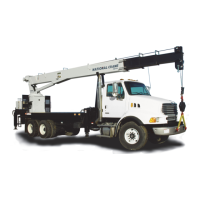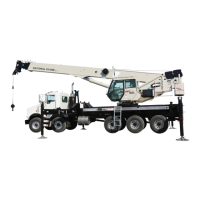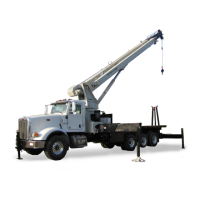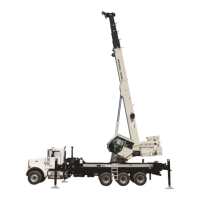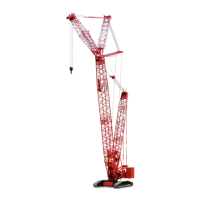LUBRICATION PROCEDURE AND CHARTS OPERATOR MANUAL 600E2
5-2 PUBLISHED 04-26-2019 CONTROL # 113-09
grease is a heavy duty extreme pressure type lubricant
(Lubricate Low Temp or equal).
Anti-wear Additives
Excessive wear in the system may cause a loss in volumetric
efficiency, and may cause shutdowns for maintenance. An
efficient anti-wear oil protects the components against
rusting, resists oxidation, and helps prevent wear.
Hydraulic Oil
Oil in a hydraulic system serves as the power transmission
medium, system lubricant and coolant. Selection of the
proper oil is essential to ensure satisfactory system
performance and life. The most important factors in selecting
an oil for hydraulic service are viscosity and anti-wear
additives.
Standard Hydraulic Oil
Above 10°F (-12°C)
The factory fill standard hydraulic oil is ISO grade 46/68. This
fluid is acceptable for operating temperatures above 10°F (-
12°C).
Intermediate Hydraulic Oil
(-10°F to 80°F) (-23°C to 27°C)
For colder operating environments, the standard fluid may be
replaced with a Low Service Temperature Multi Viscosity
Hydraulic Oil with High Viscosity index 175+.
Wide Range Intermediate Hydraulic Oil
(-30°F to 80°F) (-34°C to 27°C)
For even colder operating conditions, the standard fluid may
be replaced with a petroleum based fluid developed
especially for colder environments.
Arctic Hydraulic Oil
(-10°F and below) (-23°C and below)
In general, petroleum based fluids developed especially for
low temperature service may be used with satisfactory
results. However, certain fluids, such as halogenated
hydrocarbons, nitro hydrocabons and phosphate ester
hydraulic fluids might not be compatible with hydraulic
system seals and wear bands. Arctic hydraulic oil is not
recommended for service in ambient temperatures above
32°F (0°C).
If you are in doubt about the suitability of a specific fluid,
check with your authorized National Crane distributor or
Manitowoc Crane Care.
NOTE: All fluids and lubricants may be purchased by
contacting the Manitowoc Crane Care Parts
Department.
LUBRICATION POINTS
A regular frequency of lubrication must be established based
on component operating time. The most efficient method of
keeping track of lube requirements is to maintain a job log of
crane usage.
All oil levels are to be checked with the crane parked on a
level surface in transport position, and while the oil is cold,
unless otherwise specified. On plug type check points, the oil
levels are to be at the bottom edge of the fill port.
Over lubrication of non-sealed fittings will not harm the
fittings or components, but under lubrication shortens
lifetime.
Worn grease fittings that do not hold a grease gun, or those
that have a stuck check ball, must be replaced.
When wear pads or rotation bearings are lubricated, cycle
the components and lubricate again to ensure complete
lubrication of the entire wear area.
Surface Protection for Cylinder Rods
Steel cylinder rods include a thin layer of chrome plating on
their surfaces to protect them from corroding. However,
chrome plating inherently has cracks in its structure which
can allow moisture to corrode the underlying steel. At typical
ambient temperatures, hydraulic oil is too thick to penetrate
these cracks. Normal machine operating temperatures will
allow hydraulic oil to warm sufficiently to penetrate these
cracks and if machines are operated daily, protect the rods.
Machines that are stored, transported, or used in a corrosive
environment (high moisture, rain, snow, or coastline
conditions) need to have the exposed rods protected more
frequently by applying a protectant. Unless the machine is
operated daily, exposed rod surfaces will corrode. Some
cylinders will have rods exposed even when completely
retracted. Assume all cylinders have exposed rods, as
corrosion on the end of the rod can ruin the cylinder.
It is recommended that all exposed cylinder rods be
protected using Boeshield
®
T-9 Premium Metal Protectant.
Manitowoc Crane Care has Boeshield T-9 Premium Metal
CAUTION
Operation of the crane with incorrect hydraulic oil in sub
freezing temperature (below 32°F, 0°C) can cause
damage to the extend cylinder.
CAUTION
Lubrication intervals (page 5-2) are to be used only as a
guide. Actual intervals should be formulated by the
operator to correspond accordingly to conditions such as
continuous duty cycles and/or hazardous environments.
Fo
r
Reference
Only

